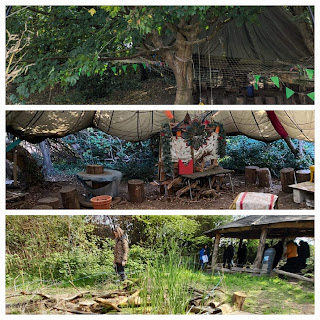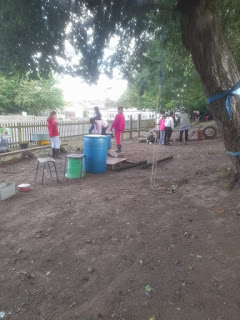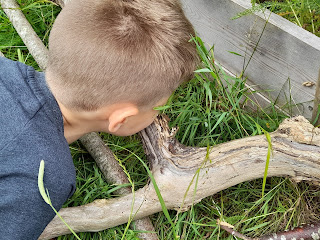Provision
Forest School comes in all sorts of shapes and sizes. In the way that schools can have varying facilities, equipment, departments, grounds, class sizes, staffing, and buildings, basecamp can be centred at the heart of all sorts of Forest Schools.
We have 3 sites on our school grounds. Each lends itself to different aspects of Forest School.
The Wildlife Garden has old and new trees, a large pond, and space for planting to attract all kinds of British Wildlife. There's a hidden mud kitchen and a 'secret' woodland and space for activities to take place.
Under the Trees is amongst a mature woodland strip, where there are plenty of boughs strong enough to hold up swings and tyres. Their trunks support slack lines and provide space to climb. We have old bricks and a long mud kitchen to explore.
The Copse is a cluster of trees that hides basecamp beautifully. There are a few child-designed structures around it and access to a long strip of woodland. It has swings, den spaces, trees to climb, an ever-growing mud kitchen, and a large dig pit.
Every session offered runs on the Forest School principles, is child-led, and allows independent exploration. The environment of each dictates some of the activities that are set up, and the strengths of the Forest School Leader using the space further influence provision.
We know this and we work with it.
Sometimes though, I hear people comment on provision as if every setting is built on the same physical foundation.
In recent weeks I have had the privilege of visiting several new and established Forest School sites. These range from being the end of a school field, adjacent to a school playground, hidden away on a corner of the premises, and next door to the School entrance. Some have had nothing but mature trees while others have added to their area with baby trees from the woodland trust. I've seen flat spaces, slopes, mounds, grass, mud, mulch, and even a little concrete. Sites have been small enough to see 90% of the area from one spot, others require staff to patrol, they are long strips of land and they are odd-shaped sites wrapping around buildings, and each is utterly influenced by its environment.
It's hard to offer slack lines if there are no sturdy supports. It's difficult to allow digging on concrete. Rolling down slopes requires... a slope! Swings and dangling tyres need appropriate boughs to hang from. A designated climbing tree needs to be sturdy and climbable.
It doesn't mean activities cannot be planned or enjoyed, just that they will look very different in different settings. Mud kitchens can be an entire undercover 'room', or a small space on the floor with a few pans. Bug hunting can be under old, naturally accumulated rotting logs on woodland floor, or there can be an assortment of materials provided to entice them in. Birds may be twittering all around or scarce to spot. Dig Pits may be a fenced-off corner of the site or a purpose-built planter.
Every site has strengths and adapting each takes time, effort, and resources, often it requires some kind of funding and frequently involves working in your own time too.
If you have some form of ownership of site, or storage, or are not open to the public providing a wide range of activities is easier because you do not have to transport everything on the day. Equally, the ability to slowly allow things to evolve while involving the children in those changes is simpler.
However, holding a session in the woods where there are less pathways and the trees and shrubbery is more untouched opens up an entirely different world of exploration.
Neither is perfect.
When I visit a setting to assess a Student Forest School Leader they often start by apologising for the lack of space, or the smallness of the mud kitchen, or how few trees there are... None of which I'm there to look at! I think of it as akin to the way on entering someone's home they immediately apologise for the bowls of washing up in the sink, or clothes on the airer, or toys strewn around, as if we don't all have to put up with these things in our own home!
I'm not there to seek the most spectacularly resourced activities I've ever seen! Nor the biggest
bughouse, most bird feeders, widest digging area, nor the cleanest mud kitchen!
I want to see that the provision is suitable for the age and/or development of the children. I want to see that the planning has built on what the children liked before, what has been achieved so far, and is progressing. I want to see engaged children following their own interests under the observation of an adult who knows how to keep them safe and extend their learning.
So here are five things I will always be watching out for:
- The flexibility to throw away all plans for a focus activity because what the children have decided to pursue is worth exploring is essential.
- Things frequently don't go to plan. Going 'wrong' isn't an issue, how you deal with that is.
- Process over product.
- The safety of the site. Risky play is welcomed, just make it clear where the boundaries and fail-safes are in place.
- Children being independent and curious and having FUN!











Comments
Post a Comment